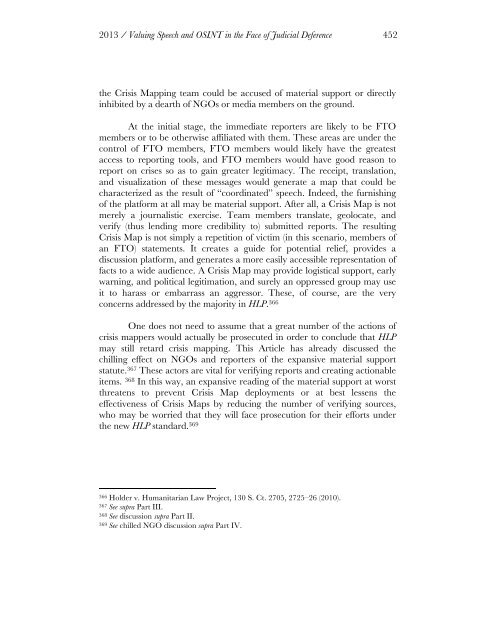Vo.4-Moshirnia-Final
Vo.4-Moshirnia-Final
Vo.4-Moshirnia-Final
Create successful ePaper yourself
Turn your PDF publications into a flip-book with our unique Google optimized e-Paper software.
2013 / Valuing Speech and OSINT in the Face of Judicial Deference 452<br />
the Crisis Mapping team could be accused of material support or directly<br />
inhibited by a dearth of NGOs or media members on the ground.<br />
At the initial stage, the immediate reporters are likely to be FTO<br />
members or to be otherwise affiliated with them. These areas are under the<br />
control of FTO members, FTO members would likely have the greatest<br />
access to reporting tools, and FTO members would have good reason to<br />
report on crises so as to gain greater legitimacy. The receipt, translation,<br />
and visualization of these messages would generate a map that could be<br />
characterized as the result of “coordinated” speech. Indeed, the furnishing<br />
of the platform at all may be material support. After all, a Crisis Map is not<br />
merely a journalistic exercise. Team members translate, geolocate, and<br />
verify (thus lending more credibility to) submitted reports. The resulting<br />
Crisis Map is not simply a repetition of victim (in this scenario, members of<br />
an FTO) statements. It creates a guide for potential relief, provides a<br />
discussion platform, and generates a more easily accessible representation of<br />
facts to a wide audience. A Crisis Map may provide logistical support, early<br />
warning, and political legitimation, and surely an oppressed group may use<br />
it to harass or embarrass an aggressor. These, of course, are the very<br />
concerns addressed by the majority in HLP. 366<br />
One does not need to assume that a great number of the actions of<br />
crisis mappers would actually be prosecuted in order to conclude that HLP<br />
may still retard crisis mapping. This Article has already discussed the<br />
chilling effect on NGOs and reporters of the expansive material support<br />
statute. 367 These actors are vital for verifying reports and creating actionable<br />
items. 368 In this way, an expansive reading of the material support at worst<br />
threatens to prevent Crisis Map deployments or at best lessens the<br />
effectiveness of Crisis Maps by reducing the number of verifying sources,<br />
who may be worried that they will face prosecution for their efforts under<br />
the new HLP standard. 369<br />
366 Holder v. Humanitarian Law Project, 130 S. Ct. 2705, 2725–26 (2010).<br />
367 See supra Part III.<br />
368 See discussion supra Part II.<br />
369 See chilled NGO discussion supra Part IV.
















